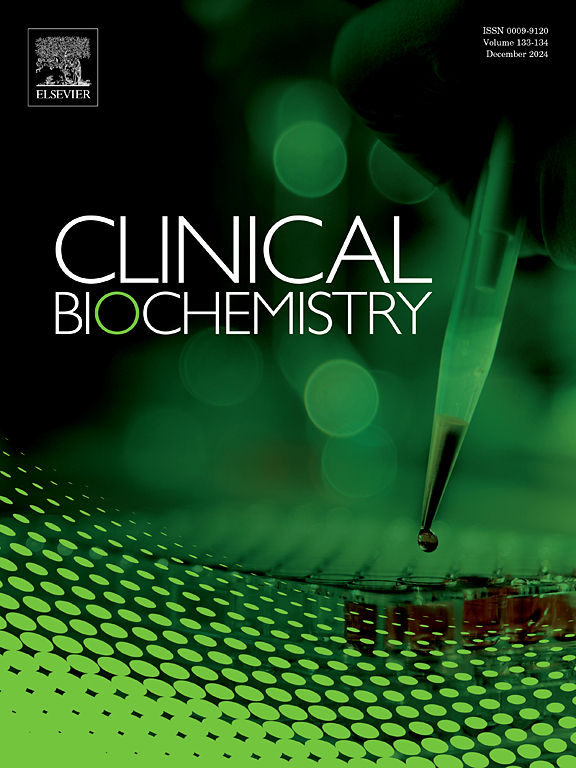评估糖尿病即时血糖监测设备的准确性、临床有效性和分析线性:一项系统回顾和荟萃分析
IF 2.1
3区 医学
Q2 MEDICAL LABORATORY TECHNOLOGY
引用次数: 0
摘要
护理点技术(POCT)因其快速的周转时间而被用于糖尿病管理。然而,其结果的准确性和可靠性却令人担忧。本综述旨在按照 ISO 15197 标准评估 POCT 检测血糖浓度的 (i) 准确性、(ii) 临床有效性和 (iii) 线性。研究按照 PRISMA 框架进行。在 Scopus、PubMed、DOAJ 和 Cochrane 图书馆中以 "护理点检测 "或 "POCT"、"准确性 "和 "葡萄糖 "为检索词进行了搜索。使用 QUADAS-2 工具进行质量评估。使用了比例和系数荟萃分析。纳入了近期(2019-2023 年)评估 POC 设备血糖估测准确性的研究。从纳入的 30 项研究中确定了 4918 名参与者和 56 个 POC 品牌。对于血糖浓度<100 mg/dL (<5.6 mmol/L),POCT结果在±15 mg/dL (±0.83 mmol/L)范围内的汇总百分比为:专业用血糖仪为98.83% (95 % CI: 96.52-99.92),家用血糖仪为87.70% (95 % CI: 62.65-99.65)。血糖浓度≥100 mg/dL (≥5.6 mmol/L)时,汇总百分比分别为 98.59 % (95 % CI: 95.90-99.88) 和 88.79 % (95 % CI: 67.35-99.44)。在一致误差网格分析的 A 区和 B 区,专业用血糖仪的测量结果为 98.06 %(95 % CI:94.59-99.80),家用血糖仪的测量结果为 98.70 %(95 % CI:95.85-99.95)。专业用血糖仪的综合相关系数为 0.988(95 % CI:0.980-0.993),而家用血糖仪的综合相关系数为 0.930(95 % CI:0.869-0.963)。专业用血糖仪符合 ISO 15197 准确性标准,但不符合临床有效性标准,而家用血糖仪既不符合准确性标准,也不符合临床有效性标准。与家用血糖仪相比,专业血糖仪的准确度更高。鉴于 POC 设备在分析性能方面的差异,建议在选择 POCT 设备时应小心谨慎,以便在糖尿病管理中得到最佳应用。本文章由计算机程序翻译,如有差异,请以英文原文为准。

Assessment of accuracy, clinical validity, and analytical linearity in point-of-care glucose monitoring devices for diabetes mellitus: A systematic review and meta-analysis
Point-of-care technology (POCT) is utilized in diabetes management due to its fast turnaround time. However, the accuracy and reliability of its results are of concern. This review aims to evaluate the (i) accuracy, (ii) clinical validity and (iii) linearity of POCT for blood glucose concentration following ISO 15197. The study was conducted following the PRISMA framework. Searches with the search term “point of care test” OR “POCT” AND “Accuracy” AND “glucose” were made on Scopus, PubMed, DOAJ, and Cochrane Library. Quality assessments were performed using the QUADAS-2 tool. Proportion and Coefficient meta-analyses were used. Recent studies (2019–2023) evaluating the accuracy of POC devices in blood glucose estimation were included. 4918 participants and 56 POC brands were identified from the 30 included studies. The pooled percentage of POCT results within ±15 mg/dL (±0.83 mmol/L) for glucose concentrations <100 mg/dL (<5.6 mmol/L) was 98.83 % (95 % CI: 96.52–99.92) for professional use and 87.70 % (95 % CI: 62.65–99.65) for home-use glucometers. For glucose concentrations ≥100 mg/dL (≥5.6 mmol/L), the pooled percentages were 98.59 % (95 % CI: 95.90–99.88) and 88.79 % (95 % CI: 67.35–99.44), respectively. Measurements in zones A and B of the consensus error grid analysis were 98.06 % (95 % CI: 94.59–99.80) for professional-use and 98.70 % (95 % CI: 95.85–99.95) for home-use glucometers. The pooled correlation coefficient for professional-use glucometers was 0.988 (95 % CI: 0.980–0.993) while home-use was 0.930 (95 % CI: 0.869–0.963). While professional-use glucometers met ISO 15197 accuracy criteria but not clinical validity standards, home-use devices failed to meet both accuracy and clinical validity criteria. Professional-use glucometers demonstrated superior accuracy compared to home-use glucometers. Based on the variability in analytical performance of POC devices, it is recommended that proper care be taken when selecting POCT devices for optimal use in diabetic management.
求助全文
通过发布文献求助,成功后即可免费获取论文全文。
去求助
来源期刊

Clinical biochemistry
医学-医学实验技术
CiteScore
5.10
自引率
0.00%
发文量
151
审稿时长
25 days
期刊介绍:
Clinical Biochemistry publishes articles relating to clinical chemistry, molecular biology and genetics, therapeutic drug monitoring and toxicology, laboratory immunology and laboratory medicine in general, with the focus on analytical and clinical investigation of laboratory tests in humans used for diagnosis, prognosis, treatment and therapy, and monitoring of disease.
 求助内容:
求助内容: 应助结果提醒方式:
应助结果提醒方式:


